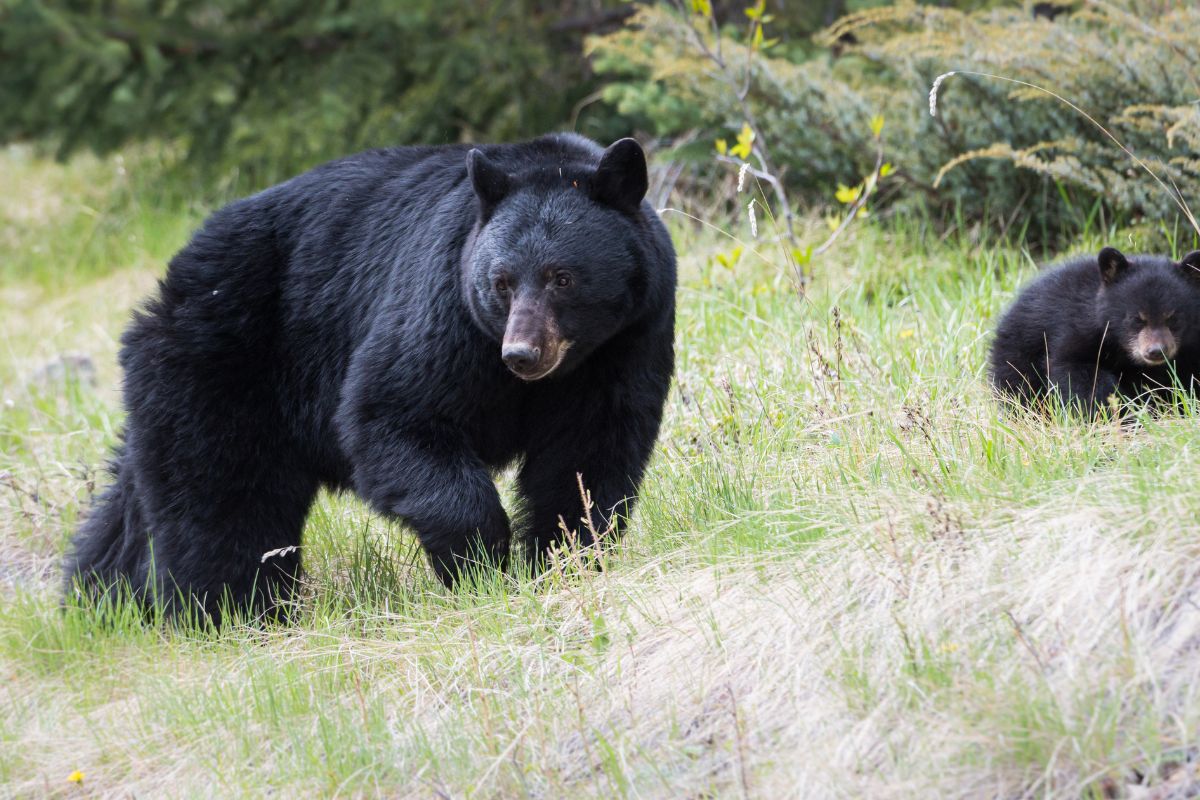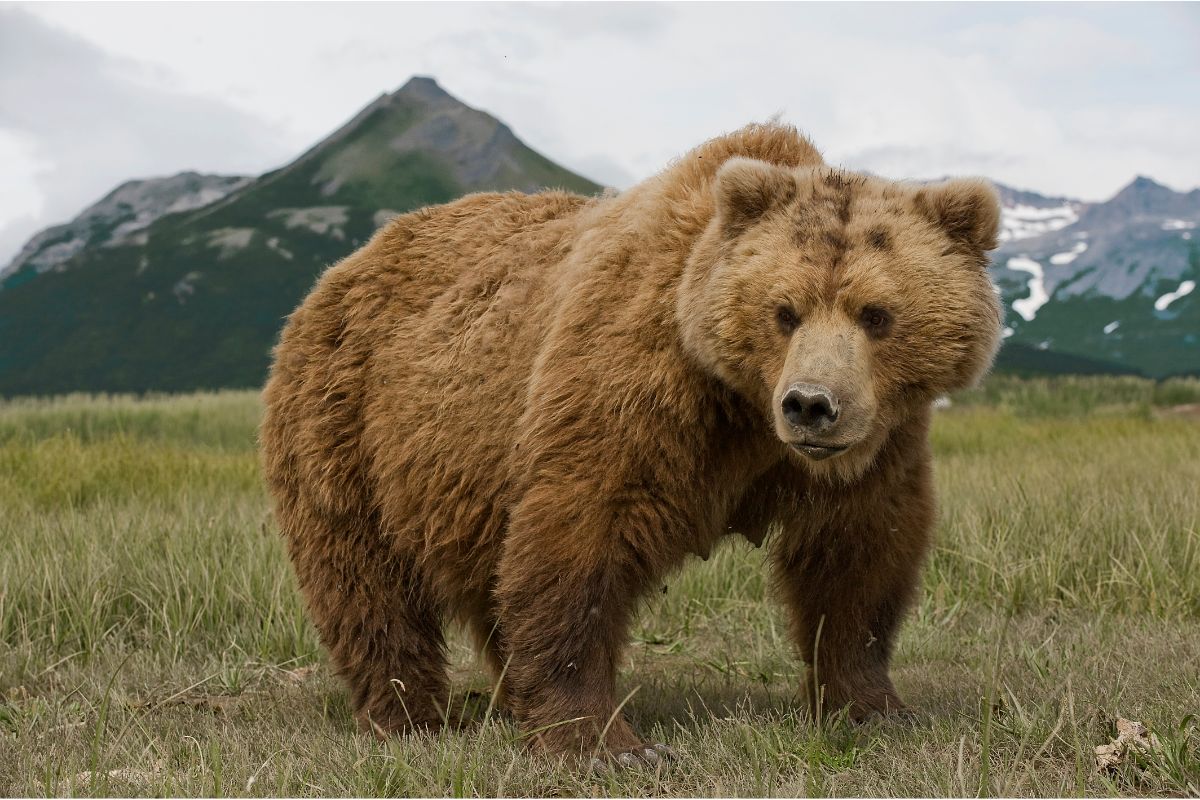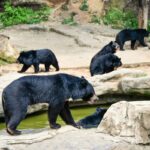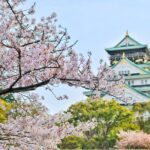Did you know that there are actually bears in Japan?
Yes! There are actually wild bears which roam around certain areas of Japan. This is a surprising fact for a lot of people because when people think of Japanese animals, they think about cranes or whales or foxes.

But Japan does indeed have not one, but two species of bears in its country – so what are they? Check out the guide below for all the information you need to know about Japan’s two ferocious species of bears.
Japanese Black Bear
The first of Japan’s wild bears we are covering is the Japanese black bear.
Appearance
It’s very small compared to its mainland cousins, the Asiatic black bears, with males weighing a maximum of 260 lbs and females 220 lbs.
Their total body length is only around 50 inches long so as far as bears go, these bears are pretty small. Even when they stand up, they are roughly the same height of a human man and no bigger!
Like other black bears, the Japanese black bear has a thick coat of black fur. On their chests, there is a flash of pale yellow fur that resembles a crescent moon.
Behavior
The Japanese black bear is a relatively shy species of bear as they avoid humans and are not generally aggressive. They are nocturnal and live in forestry, away from human habitats.
Like all bears, they hibernate during the winter in dens made under trees or rocks.
What makes the Japanese black bear so unusual is that it is typically herbivorous. Lots of species of bears are omnivorous which means they eat both plants and animals.
Japanese black bears, however, typically eat only plants. Their diet is mostly made up of grass, acorns, berries, buds and nuts. Their sharp claws make them expert climbers and they can easily access all kinds of nuts and berries found on tall trees.
However, the Japanese black bear will turn omnivorous if resources are low. They will try to eat wild animals including wild boar and Japanese serow, along with livestock from nearby human towns.
Cannibalism can also occur with Japanese black bears. Cub claws were once discovered in the belly of a male Japanese black bear as evidence of this.
However, this does not mean that Japanese black bears regularly kill and eat their own cubs. This is likely a scenario where a male has killed the cubs of a rival male to force the female to breed – a common occurrence in the animal kingdom.
Habitat And Threats
The Japanese black bear is a critically endangered species and is quickly losing territory in Japan. Today, the Japanese black bear has habitats on the Honshu and Shikoku islands of Japan, in areas with plenty of trees and grass.
They used to also live on the island of Kyushu but have gone extinct there.
There are an estimated 10,000 Japanese black bears left in the wild. Although that number may seem like a lot, that is nowhere near what their numbers should be. In 2006, humans were responsible for killing nearly 5,000 Japanese black bears!
The reason why Japanese black bears are on the decline is because of human encroachment.
They are losing territory to humans. Not only are humans using their territory for new farms and villages, but they are also cutting down the trees Japanese black bears feed from.
Japanese black bears are also poached and sold on the black market for a high price as they are very desirable.
As a result, the Japanese black bear is likely to be extinct within the next century.
Mythology
Japan is well known for its amazing folklore. Although black bears themselves are not commonly referenced, they may be the inspiration behind a type of oni (see also ‘What Is An Oni? – Japanese Demons Explained‘).
The onikuma is an oni that appears in Japanese folklore. It is a massive monstrous black bear which walks on its hind legs and carries away horses to eat during the night. They are super strong and their favorite food is horses.
In most art depictions, the onikuma shares a lot of similarities with the Japanese black bear – including the patch of pale fur on their chests or neck. Japanese black bears also tend to walk around on their hind legs too!
This has led many people to believe that the Japanese black bear was the inspiration for the onikuma.
However, as we mentioned earlier, the Japanese black bear is typically herbivorous. This means that they are unlikely to ever hunt horses.
It could be that these stories were born when Japanese black bears had little else to eat and so, they hunted horses.

Ussuri Brown Bear
The second type of bear found in Japan is the Ussuri brown bear.
Appearance
The Ussuri brown bear is one of the largest species of bear in the world. Males typically weigh around over 800 lbs, with females weighing a little bit less, and are on average 6 to 9 feet long.
This makes them much bigger than the Japanese black bear!
As for coloring, Ussuri brown bears are typically covered in dark brown or black fur. Their faces are paler than the rest of their body but they have no other distinctive markings.
Behavior
If approached, Ussuri brown bears are not afraid to start to act aggressively. However, in an area of Banya in the Shiretoko Peninsula, female Ussuri brown bears often approach fishermen and happily spend their time around humans.
Despite this, there have been no casualties recorded.
The reason behind this unusual behavior is likely due to males. Male Ussuri brown bears are much more aggressive than females and will attack cubs to try and force the females to breed.
As a result, it’s likely females take their cubs to be around humans to avoid male Ussuri brown bears. Male Ussuri brown bears avoid human territory in general so it makes sense that females would go to those areas to keep their cubs safe.
As for their diets, Ussuri brown bears usually live on nuts and berries but they will also eat mammals, fish, and birds.
During the warmer seasons, Ussuri brown bears will live off vegetation but gradually add more meat to their diet during the fall as hibernation approaches.
Habitat And Threats
Most Ussuri brown bears live across the continent in countries like Russia and Korea. However, they also have territory in the Hokkaido region of Japan.
In general, the species is vulnerable as a lot of Ussuri brown bears are losing their habitat due to deforestation. Timber industries are cutting down forests at amazing rates.
This means more and more Ussuri brown bears are losing their homes every year.
However, another threat to Ussuri brown bears in Japan is their unpopularity with humans. Ussuri brown bears have been behind a lot of attacks and deaths in Hokkaido.
As a result, a lot of people in Hokkaido view the bears as ‘man-eating’ beasts and view them as a dangerous threat.
Final Thoughts
So, there are two types of bears that live in Japan. The Japanese black bear is native to the region but their numbers are sharply declining.
On the island of Hokkaido, you can also find Ussuri brown bears – but don’t get too close! These bears are aggressive!
- How Much Money Can You Make Teaching English in Japan? - December 12, 2022
- The Best Places to Teach English in Japan - December 9, 2022
- The Best Credentials for Teaching English in Japan - December 8, 2022



![Native & Wild Animals That Live In Japan [Wildlife Guide] Native & Wild Animals That Live In Japan [Wildlife Guide]](https://justaboutjapan.com/wp-content/uploads/2022/09/Native-Wild-Animals-That-Live-In-Japan-150x150.jpg)




